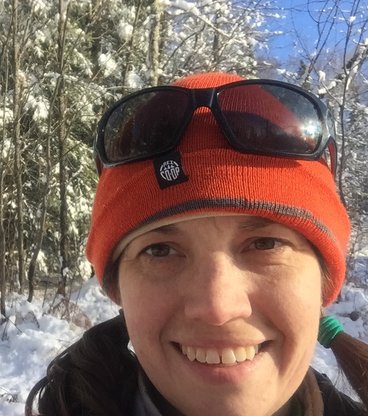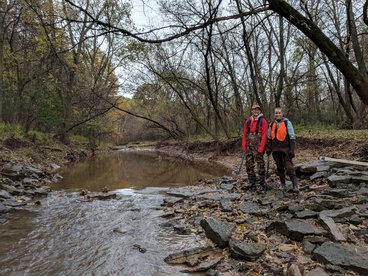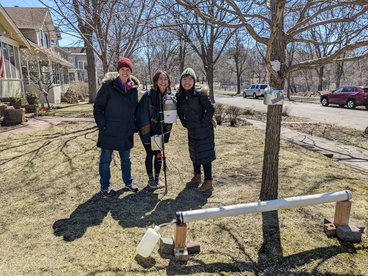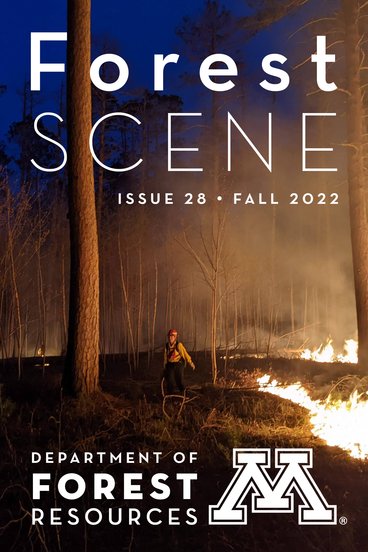
As a hydrologist in the Department of Forest Resources, Dr. Diana Karwan studies water movement and how watersheds function. More specifically, her team collects water and soil samples to analyze how sediment, chemicals and other pollutants are, over time and distance, moved from landscapes to streams, rivers, and other receiving bodies of water.
The big question is, how do streams and rivers respond to different weather events, land cover management methods, or landscape changes over time, and do patterns emerge to predict a long-term trajectory? If there’s a change in weather patterns or a change in land cover management, what might that mean for the quantity and the quality of water in a stream or river? Not only do the analysis tools show what water brings over physical distances, but there is also a connection to the changes that occur over time. One of the areas where the hydrology team works on those questions is in Wisconsin streams that drain into Lake Michigan. Most of these streams are surrounded by agricultural landscapes, consisting of Wisconsin dairy farms and small forest pockets.
“In order to test our expectations, we need to allow for some assessment of whether land management practices are having an effect and how that effect might be teased apart as you move further downstream. Is it working right next to the farm where they put the buffers in to see if there is an effect further downstream? How long does it take these signals of practices on the landscape to make it to the larger river or to Green Bay? It’s not always immediately clear what the effects of different land management methods might be, so it becomes a process of both diagnosis and prediction.”

In the urban landscape, Dr. Karwan and collaborator, Dr. Xue Feng in the Department of Civil, Environmental and Geo-Engineering, began a project this summer in partnership with the St. Paul Parks Department, the Minneapolis-St. Paul Metropolitan Area Long Term Ecological Research Project and the Minnesota Stormwater Research Council to measure water quality and quantity fluxes and understand the role trees play in an urban water system.
“We’re working with Saint Paul to take advantage of their structured ash tree removal program — trees that have been affected by the Emerald ash borer are being strategically removed and have historically been well documented and monitored. We wanted to work with them to monitor trees that are still standing and scheduled to be removed in a year or two, to create a clear before and after picture of the effect of tree canopy on rain water as it falls.”
This interdisciplinary team works in city parks near recreation centers and playgrounds which means data and sample collecting must be done in clusters of smaller footprints. It also makes the project more interactive than in an experimental forest where you only need to worry about animals. To communicate with people in the parks, a student on the project created a QR code sign for the collection sites so curious members of the public can email questions to the team. The team also receives alerts from neighbors who notice when a storm or high winds have knocked over a data logger or sensor.

For Dr. Karwan, one of the most exciting aspects of being a researcher is figuring out how things work — how does water get to its destination, and what does it go through on the way there? The progression from inspiration to discovery is exciting for Dr. Karwan — the first urban water project collection was conducted in her front yard. “And so, I think about this a lot, particularly in my teaching capacity. I talk about how there is hydrology behind aspects of how people observe water in their everyday life. We’re trying to encourage people to think about how that water got to where they’re drinking it from and how the quality of the water we’re using relies on that relationship of the water with the environment. I try to think of things through a hopeful lens, for example, how fortunate I am to conduct water research in a state with relatively abundant water resources.”

The Forest Scene newsletter is published biannually in the spring and fall, featuring stories and updates from the Department of Forest Resources. Readers can download issue 28 of Forest Scene as an interactive PDF that is fully tagged and compatible with most screen readers, or read the individual stories here in a web-based format.
